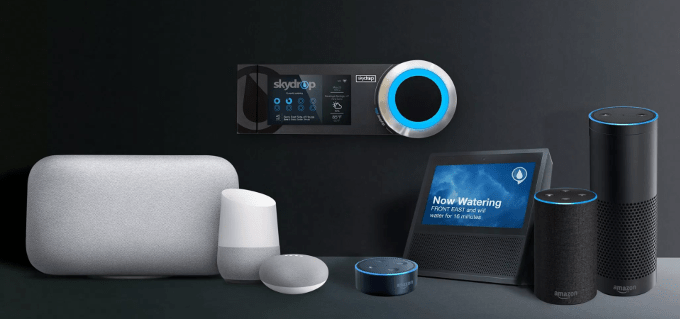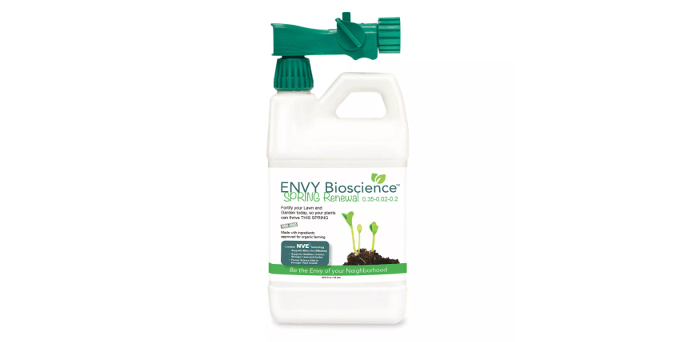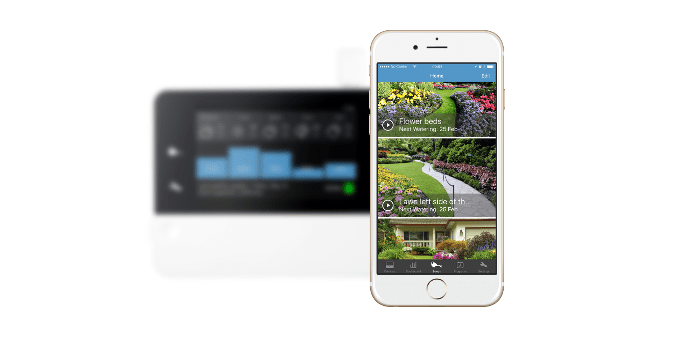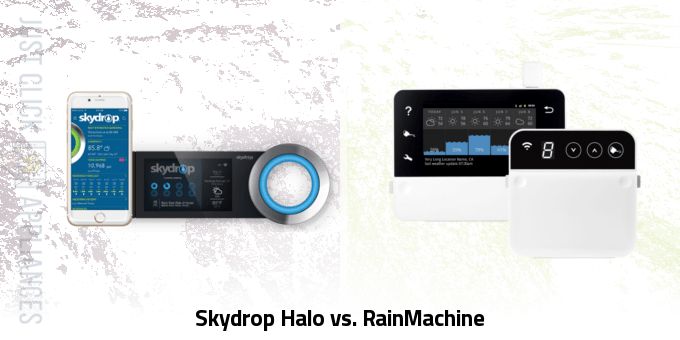Investing in a smart sprinkler control system is an excellent way to save water, save money, and make keeping your lawn green a more convenient task.
Below we get deep into the details in a comparison of Skydrop Halo vs. RainMachine. Either choice will be a massive upgrade over your existing sprinklers, but we break down what each system has to offer to help make your purchasing decision just a little bit easier.
Skydrop Halo vs. RainMachine — About
When it comes to smart sprinkler systems, there are more brands on the market than ever before that all offer their own take on convenient and efficient watering. The Skydrop Halo and RainMachine product line represent two major names in the field that both have different things to offer.
The Skydrop Halo offers superior weather tracking that keeps an eye on a huge number of different metrics — automatically adjusting your watering schedule to match the needs of your lawn. It’s the more sophisticated model in the Skydrop line, representing a more premium product when compared to the less expensive Skydrop Arc Sprinkler Controller.
While the Skydrop Halo is one of the most sophisticated products on the market, the RainMachine offers some stiff competition. With three different models that all offer varying levels of benefits at varying price points, there’s something available to suit pretty much any homeowner’s needs. The touchscreen interface makes manual control a breeze, but you shouldn’t need to adjust settings very often with automatic weather tracking from major services like NOAA, NetAtmo, Wunderground and more.
Both machines share a good number of commonalities (which we’ll go into below), but there are also some pretty significant differences that may sway your decision one way or another.
Skydrop Halo vs. RainMachine — Things in Common

Let’s get into what both products have to offer, so you know what you’re getting as a baseline regardless of your choice. At their base, both smart sprinklers offer a wide selection of features that ensures your lawn will be healthy and happy.
Both the Skydrop Halo and RainMachine offer 8, 12, and 16-zone models, although they do differ in how they do so. The RainMachine has three separate models that cover each of the three zone requirements, while the Skydrop Halo has an 8-zone model that can be extended to 16 zones via a Skydrop Expansion. If you’re looking for a 12-zone model that falls right in the middle, you’ll have to opt for the Skydrop Arc — another excellent smart sprinkler control system in the Skydrop product family.
With either device, you’ll be able to control the settings at will with on-unit manual control. However, you shouldn’t need to very often due to their advanced Weather Intelligence as well as support for popular voice controllers like Amazon Alexa and Google Assistant.
The Skydrop Halo and RainMachine also offer support for Wink and Nest which unlocks greater integration within your connected home, although you may need to use IFTTT to enable the features on select devices. IFTTT is especially helpful, as it lets you do some pretty creative things with other smart devices and controllers. As a conditional trigger system, the possibilities are pretty endless and this makes for a sprinkler control system that lets you heavily customize your sprinkler to work in tandem with the rest of your home.
Both devices are controllable via a smartphone app for iOS or Android, and communicate wirelessly over a standard 2.4GHz 802.11 b/g/n connection. Lastly, either system will be backed by a 2-year warranty that ensures your purchase will be protected from any malfunctions or defects for a substantial amount of time.
Skydrop Halo vs. RainMachine — Differences
-
Difference #1: Zone Control – While the Skydrop Halo and RainMachine product lines both offer options for zone control in 8, 12, and 16-zone options, they differ in how they do so.
The Skydrop product family definitely has an advantage in this category. The device by default has support for 8 zones, but you can buy a Skydrop extender in order to double the number of zones to 16. It’s the perfect option for those who aren’t sure how many zones they’ll need at first, since it allows you to expand things pretty easily with the optional accessory. If you’re looking for an option that falls somewhere in the middle, consider taking a look a the Skydrop Arc model which supports 12 zones.
No products found.
The RainMachine also offers the ability to choose between 8, 12, and 16 zones, but each option is part of a separate model. So, you’ll need to have an idea of the type of customization and coverage you need before you make the purchase, as there’s no option for expansion.
-
Difference #2: Sensors – While the Skydrop may have the edge when it comes to zone control, but the tables are flipped when it comes to support for sensors.
The RainMachine interfaces well with rain sensors which serves as a backup on the off chance that the weather detection doesn’t work as intended. However, the RainMachine’s weather tracking is excellent due to its multiple high precision environmental sensors flying above earth in polar-orbiting and geostationary orbits. These satellites are owned and operated by NOAA, and provide some of the most accurate information when it comes to sprinkler control systems. The combination of superior weather tracking and the backup of rain sensors means that you’ll never have to worry about the process of keeping your lawn green while saving water and money.
The Skydrop Halo, unfortunately, does not support sensors. This isn’t the end of the world due to their comprehensive weather monitoring system that tracks metrics like precipitation — all updated on an hourly basis to ensure your watering schedule adjust as necessary to match the current weather. humidity, temperature; wind, solar radiation, and more. In most cases, this should be more than enough to make sure your lawn stays in optimal condition. If the weather systems were to go down or lose connection to your device, however, you may notice the disadvantages of not having a sensor.
If you’re looking for a Skydrop model with sensor support, considering looking into the Skydrop Arc instead.
-
Difference #3: Local Connect – Since both devices connect via WiFi, this is the primary way in which they will receive data about the weather and adjust your sprinkler watering accordingly. But what happens should your internet connection go down? Even the most stable networks have their hiccups, and it would be nice to know that your sprinklers would continue working as intended even if your wireless signal were to be interrupted. The two devices differ in how they handle an interruption in connection.
The Skydrop requires access to the internet to change settings, but if you’ve connected to the cloud at any time the system will continue to watering based on a backup watering schedule stored in the device’s history. This schedule lacks the smart watering intelligence, but will still take steps to adjust based on seasonal information from historical data. Without an internet connection, however, you will not be able to access the mobile app or web browser and control the various settings — forcing you to use the interface on the device itself and lacking a lot of the smart features that make it so great to begin with.
The RainMachine uses local connect. This technology allows you to access your system and manage key watering features such as active / inactive programs, active / inactive zones, freeze protection, hot weather adjustments, and more. It’s definitely easier to control the RainMachine in absence of a connection, so if you’re worried about the reliability of your WiFi it may be the better choice. You’ll still need a wireless connection in order to take advantage of some of the smart features that come through weather prediction, but you can control pretty much any other setting through local connect.
-
Difference #4: Cloud – One thing to keep in mind with a lot of these smart sprinkler systems is that they rely on the company’s cloud in order to receive and issue commands. The Skydrop product family is well established and is likely to support your sprinkler control system for years to come, but if the company were to shut down their servers, you would be left with a smart sprinkler that is essentially useless.
The RainMachine has a definite advantage in this section in that it doesn’t rely on the cloud. It’s pretty unique in that aspect, so if you’re looking for a smart sprinkler control system that doesn’t rely on an external company to function, any of the company’s three models will likely be the optimal choice. In order to get weather data, it connects through WiFi to trusted National and International weather data sources that will continue to persist if the company were to go under — ensuring that you can push as much life out of your new system as possible.
Both companies are pretty reliable and will likely serve you with comprehensive smart watering for years to come, but if you’re worried about services shutting down in the future the RainMachine is clearly the superior choice.
-
Difference #5: Manual Control – Both devices have a touchscreen display on the device that makes it easy to control settings manually, but the RainMachine’s screen is much brighter, vibrant, and full of relevant information. The 6.5” touchscreen display offers an unprecedented amount of manual control over the system to those who would like to be able to adjust their settings at will, and is much more fully-featured than the Skydrop’s 4.3” color LCD screen.
Essentially, the RainMachine screen is much more intuitive and easy to use, while the Skydrop manual display is functional, but lacks a lot of the features that its competitor offers.
-
Difference #6: Outdoor Use – Both systems have relatively small profiles overall, so you should be able to fit them in pretty much anywhere. However, for those of us who have limited space inside, it’s nice to have a sprinkler control system that will function outdoors as well. One of the main advantages that Skydrop has over the RainMachine is its ability to function outside using an outdoor enclosure. It also works in temperature ranges from -22 F to 185 F, allowing you to install it in pretty much any locale.
The RainMachine models are only designed to be used indoors, which definitely limits options for installation. There is no support for outdoor enclosures, and it also has a much more narrow operating temperature range of 32 F to 122 F. It should be easy enough to find a spot for it inside, making this difference largely a non-issue, but having the flexibility to place the controller on the outside of your house is a definite advantage of the Skydrop Halo.
-
Difference #7: Dimensions – It’s a good thing you can install the Skydrop Halo outside, as it’s significantly larger than the RainMachine models. It’s still relatively petite at 11″ x 4.875″ x 4″ and 2.8 lbs, but is much bulkier and heavier than the 6″ x 4″ x 1″ dimensions and 0.7 lbs of the its competitor.
If space is at a premium in your home and you don’t want to install your sprinkler outside, the RainMachine has a much slimmer design that should find a place in basically any area of your home.
-
Difference #8: Smart Home Integration – Overall, the RainMachine has a little bit more to offer in terms of smart home integration. With support for SmartThings, Nest, and Wink, it offers more options than the Skydrop Halo which doesn’t interface at all with SmartThings. Keep in mind, however, that you’ll need to use IFTTT in order to enable the ability to work well with pretty much any of these smart home controllers — regardless of your choice.
If you’re interested in smart home technology and inter-connectivity, it’s worth learning the ins and outs of IFTTT over time due to how powerful it is. However, if you’re looking for a system that works with smart systems out of the box, you’ll likely be disappointed regardless of your choice. For a smart sprinkler system that integrates much more easily with other smart technology, we recommend taking a look at the Rachio product line. Check out our take on Rachio vs. RainMachine for more details.
Skydrop Halo vs. RainMachine — Comparison Chart
| Skydrop Halo | RainMachine | |
|---|---|---|
| 8-zone model | Yes | Mini-8 |
| 12-zone model | Skydrop Arc Model | HD-12 |
| 16-zone model | via Skydrop Expansion | HD-16 |
| Rain Sensor | No | Supported |
| Soil Sensor | No | – |
| Wired Flow Sensors | No | – |
| Manual Control | On-unit | On-unit |
| Cloud Sync | Yes | No |
| Local Connect | No | Yes |
| Weather Intelligence | Yes | Yes |
| Amazon Alexa | Yes | Yes |
| Google Assistant | Yes | Yes |
| SmartThings | No | via IFTTT |
| Wink | via IFTTT | via IFTTT |
| Nest | Yes | via IFTTT |
| IFTTT | Yes | Yes |
| App | iOS and Android | iOS and Android |
| Wi-Fi Connection | 2.4GHz 802.11 b/g/n | 2.4GHz 802.11 b/g/n |
| Temperature Range | -4°F to 185°F | 32°F to 122°F |
| Outdoor Enclosure | Available | Indoor only |
| Dimensions | 11″ x 4.9″ x 4″ | 6″ x 4″ x 1″ |
| Weight | 2.8 Lbs. | 0.7 Lbs. |
| Warranty | 2 years | 2 years |
Skydrop Halo vs. RainMachine — Accessories

When it comes to accessories, there are a couple of options we recommend to really get the most bang for your buck out of the Skydrop Halo. Both of these add-ons are situational, but the ability of the Skydrop Expansion to give you more options in terms of zone control, and the Skydrop Enclosure makes it easy to install your sprinkler controller outside.
The RainMachine is a ready-to-use system, and doesn’t really have any accessories to speak of at this point in time. The system is comprehensive in and of itself so the add-ons aren’t really necessary, but we have to admit that the lack of expansion or the ability to install outside are a best of a let down.
Skydrop Halo vs. RainMachine — Our Thoughts

Both the Skydrop Halo and RainMachine represent some of the top smart sprinkler control systems on the market, and declaring a clear winner in this comparison is a tall order.
The Skydrop Halo has comprehensive weather tracking, easy expandability, and offers more flexible installation options due to its smaller size and ability to be used outside. However, it does fall short in a few areas — namely the fact that it relies on the cloud, doesn’t integrate as well with smart systems, and doesn’t have the same manual control you’ll see with the RainMachine.
The RainMachine can’t be used outside and isn’t as customizable in terms of zone control, but we feel that it’s the superior option in nearly every other area. One of the primary influencers in our decision is the fact that it doesn’t rely on the cloud to function, which means that you’ll be able to use your system for years to come without relying on the manufacturer. Add to that the useful and vibrant touchscreen controls, support for sensors, and data collected from some of the most accurate sources around the world, and it’s easy to see it’s an absolute winner in the smart sprinkler arena.
Regardless of your choice, you’ll enjoy the savings and convenience of some of the most sophisticated smart sprinkler devices on the market. We do have to admit, however, that the RainMachine has the edge.
Last update on 2024-04-20 at 00:01 / Affiliate links / Images from Amazon Product Advertising API




